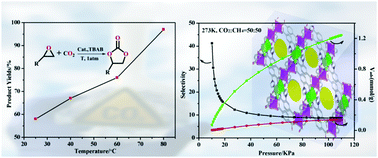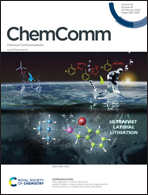A first new porous d–p HMOF material with multiple active sites for excellent CO2 capture and catalysis†
Abstract
In this work, a new monometallic metal–organic framework (MOF), namely {[Pb2(L)2(H2O)]·H2O}n (1), was prepared via a N,O-mixed 2-(imidazol-1-yl)terephthalic acid (H2L) ligand and Pb(II) ions. Then, a first new porous d–p heterometallic MOF (HMOF), namely {[PbZn(L)2]·DMA·H2O}n (2), was yielded via Zn(II) ions and MOF 1 as the precursor because of the different coordination affinity of oxygen and nitrogen atoms with various metal ions. MOF 1 is a condensed packing motif, whereas HMOF 2 is a porous three-dimensional (3D) framework with unsaturated Pb(II) and Zn(II) active sites, uncoordinated carboxylate oxygen atoms and two kinds of porous channels due to the introduction of Zn(II) ions into the framework of MOF 1, which thus endowed HMOF 2 with excellent sorption and selectivity for CO2 over CH4. Moreover, HMOF 2 was explored to be an efficient heterogeneous catalyst for the fixation of CO2 with various epoxides because of the existence of the abundant unsaturated bimetallic sites as the Lewis acid. It is hoped that this work may supply an effective strategy to build plenty of d–p HMOF materials with excellent gas adsorption and catalytic properties.

- This article is part of the themed collection: ChemComm contributions to the United Nations Sustainable Development Goals


 Please wait while we load your content...
Please wait while we load your content...